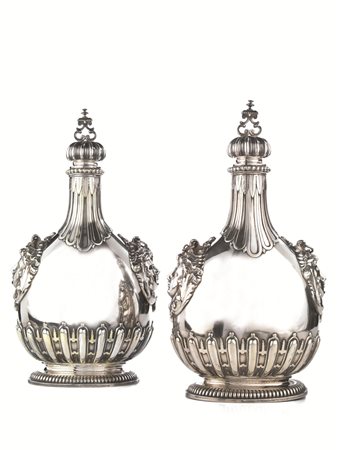 Pandolfini Casa d'Aste - Borgo degli Albizi (Palazzo Ramirez-Montalvo) 26, 50122 Firenze
Pandolfini Casa d'Aste - Borgo degli Albizi (Palazzo Ramirez-Montalvo) 26, 50122 Firenze
Capolavori da collezioni italiane Sessione Unica - dal lotto 1 al lotto 26
giovedì 1 ottobre 2015 ore 19:00 (UTC +01:00)
COPPIA DI FIASCHE DA PELLEGRINO, LONDRA, 1867, ARGENTIERE GEORGE FOX base...
COPPIA DI FIASCHE DA PELLEGRINO, LONDRA, 1867, ARGENTIERE GEORGE FOX
base ovale baccellata, parte inferiore decorata con tecnica cut-card , sui
fianchi due protomi femminili tra volute vegetali che trattengono le catenelle di
sospensione, coperchio baccellato con finale traforato a volute, alt. cm
41, g 5370, venduta da Lambert & Rawlings (2)
PAIR OF PILGRIM FLASKS, LONDON, 1867, GEORGE FOX
oval gadrooned foot, applied with lobed cut-card work, cast leaf-flanked female masks on either side with pendent heavy chain of curved links, applied with further cut-card work and stylized stiff foliage at the neck, gadrooned cover with openwork finial, 41cm high, 5370 gr., retailed by Lambert & Rawlings (2)
Il modello qui presentato riprende i modelli delle fiasche da pellegrino in maiolica o in argento già in uso dal XVI secolo. In particolare si può confrontare con l’esemplare conservato oggi al Victoria and Albert Museum di Londra (fig.1)
George Fox (1816-1910) fu figlio d’arte. Il nonno Charles Fox, infatti, fondò la ditta di argenteria nel 1801 circa in società con James Turner al numero 3 di Old Street a Londra.
La manifattura viene citata nella Holden Directory di Londra, l’elenco di mercanti e artigiani attivi in quegli anni.
La società con James Turner fu sciolta nel 1804 e Charles Fox continuò la sua professione al 139 di Old Street dove, dal 1822 , cominciò l’attività di argentiere anche il figlio Charles Fox Junior.
In questi anni la manifattura è ricordata non solo per la creazione di oggetti in argento ma anche come laboratorio per restauri e dorature.
Nel 1841 la società a conduzione familiare si arricchì anche della manodopera dei figli di Charles Fox Junior.
Charles Thomas Fox (1801-1872) e George Fox (1816-1910) cominciarono a lavorare come argentieri nella C.T.&G. Fox che dal 1852 spostò la sua sede al 13 di Queen Street. L’attività in quegli anni ebbe come principale sbocco di commercio la collaborazione con i più grandi orefici del momento come Lambert & Rawlings in Coventry Street per cui crearono anche le opere in mostra all’Esposizione Universale del 1851 ed importanti commissioni da parte delle notabili famiglie inglesi. Le fiasche qui proposte sono proprio frutto di questa collaborazione
Nel 1860 il fratello di George Fox si ritirò ed egli divenne l’unico socio dell’azienda di famiglia fino al 1910 anno della sua morte.
Cfr.:J. Culme, The Directory of Gold & Silversmiths, Jewellers & Allied Traders 1838-1914, 1987, pp. 162-163
The model we are here presenting was inspired by the majolica or silver pilgrim flasks which were already in use in the 16 th century. We can compare it in particular with the one today in the Victoria and Albert Museum, London (fig. 1).
George Fox (1816-1910) followed in the family tradition: in 1801 his grandfather Charles Fox had in fact founded a silverware company in partnership with James Turner at no. 3, Old Street, London. The manufactory is mentioned in the Holden Directory of London, the list of merchants and artisans active in those years. The partnership with James Turner was dissolved in 1804 and Charles Fox continued the business at no. 139, Old Street, where, in 1822, his son Charles Fox Junior also started working as a silversmith.








